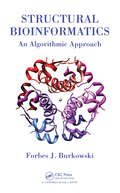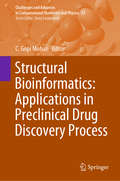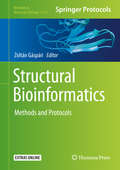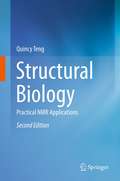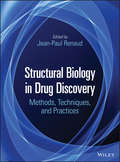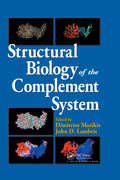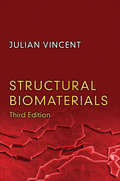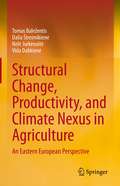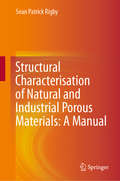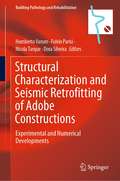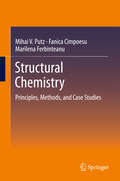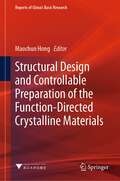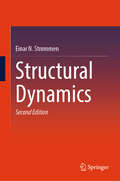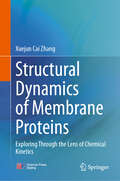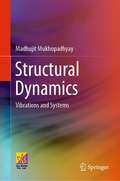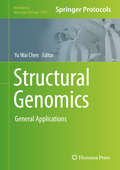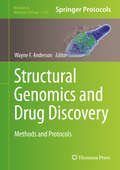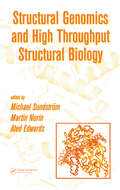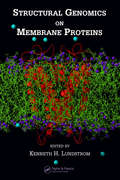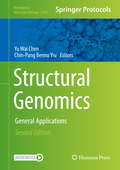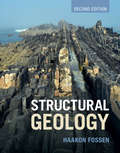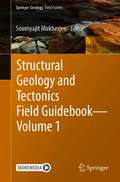- Table View
- List View
Structural Bioinformatics: An Algorithmic Approach (Chapman & Hall/CRC Computational Biology Series)
by Forbes J. BurkowskiThe Beauty of Protein Structures and the Mathematics behind Structural BioinformaticsProviding the framework for a one-semester undergraduate course, Structural Bioinformatics: An Algorithmic Approach shows how to apply key algorithms to solve problems related to macromolecular structure.Helps Students Go Further in Their Study of Structural Biolog
Structural Bioinformatics: Applications in Preclinical Drug Discovery Process (Challenges and Advances in Computational Chemistry and Physics #27)
by C. Gopi MohanThis book reviews the advances and challenges of structure-based drug design in the preclinical drug discovery process, addressing various diseases, including malaria, tuberculosis and cancer. Written by internationally recognized researchers, this edited book discusses how the application of the various in-silico techniques, such as molecular docking, virtual screening, pharmacophore modeling, molecular dynamics simulations, and residue interaction networks offers insights into pharmacologically active novel molecular entities. <P><P> It presents a clear concept of the molecular mechanism of different drug targets and explores methods to help understand drug resistance. In addition, it includes chapters dedicated to natural-product- derived medicines, combinatorial drug discovery, the CryoEM technique for structure-based drug design and big data in drug discovery. <P><P> The book offers an invaluable resource for graduate and postgraduate students, as well as for researchers in academic and industrial laboratories working in the areas of chemoinformatics, medicinal and pharmaceutical chemistry and pharmacoinformatics.
Structural Bioinformatics: Methods and Protocols (Methods in Molecular Biology #2112)
by Zoltán GáspáriThis volume looks at the latest techniques used to perform comparative structure analyses, and predict and evaluate protein-ligand interactions. The chapters in this book cover tools and servers such as LiteMol; Bio3D-Web; DALI; CATH; HoTMuSiC, a contact-base protein structure analysis tool known as CAD-Score; PyDockSaxs and HADDOCK; CombDock and DockStar; the BioMagResBank database; as well as BME and CoNSEnsX+. Written in the highly successful Methods in Molecular Biology series format, chapters include introductions to their respective topics, step-by-step, readily reproducible computational protocols, and tips on troubleshooting and avoiding known pitfalls.Cutting-edge and comprehensive, Structural Bioinformatics: Methods and Protocols is a practical guide for researchers to learn more about the aforementioned tools to further enhance their studies in the growing field of structural bioinformatics.Chapter 13 is available open access under a CC-BY 4.0 license via link.springer.com.
Structural Biology
by Quincy TengThis 2nd edition begins with an overview of NMR development and applications in biological systems. It describes recent developments in instrument hardware and methodology. Chapters highlight the scope and limitation of NMR methods. While detailed math and quantum mechanics dealing with NMR theory have been addressed in several well-known NMR volumes, chapter two of this volume illustrates the fundamental principles and concepts of NMR spectroscopy in a more descriptive manner. Topics such as instrument setup, data acquisition, and data processing using a variety of offline software are discussed. Chapters further discuss several routine stategies for preparing samples, especially for macromolecules and complexes. The target market for such a volume includes researchers in the field of biochemistry, chemistry, structural biology and biophysics.
Structural Biology in Drug Discovery: Methods, Techniques, and Practices
by Jean-Paul RenaudWith the most comprehensive and up-to-date overview of structure-based drug discovery covering both experimental and computational approaches, Structural Biology in Drug Discovery: Methods, Techniques, and Practices describes principles, methods, applications, and emerging paradigms of structural biology as a tool for more efficient drug development. Coverage includes successful examples, academic and industry insights, novel concepts, and advances in a rapidly evolving field.The combined chapters, by authors writing from the frontlines of structural biology and drug discovery, give readers a valuable reference and resource that: Presents the benefits, limitations, and potentiality of major techniques in the field such as X-ray crystallography, NMR, neutron crystallography, cryo-EM, mass spectrometry and other biophysical techniques, and computational structural biology Includes detailed chapters on druggability, allostery, complementary use of thermodynamic and kinetic information, and powerful approaches such as structural chemogenomics and fragment-based drug design Emphasizes the need for the in-depth biophysical characterization of protein targets as well as of therapeutic proteins, and for a thorough quality assessment of experimental structures Illustrates advances in the field of established therapeutic targets like kinases, serine proteinases, GPCRs, and epigenetic proteins, and of more challenging ones like protein-protein interactions and intrinsically disordered proteins
Structural Biology of the Complement System
by John D. Lambris Dimitrios MorikisOf recent, the structure of the complement system has received considerable attention, including the publication of several three-dimensional structures of complement proteins. This has led to the need for an authoritative resource to provide a complete overview of the basics, as well as an explanation of the cutting-edge work being accomplished in
Structural Biomaterials: Third Edition
by Julian VincentThis is a thoroughly revised, updated, and expanded edition of a classic illustrated introduction to the structural materials in natural organisms and what we can learn from them to improve man-made technology--from nanotechnology to textiles to architecture. Julian Vincent's book has long been recognized as a standard work on the engineering design of biomaterials and is used by undergraduates, graduates, researchers, and professionals studying biology, zoology, engineering, and biologically inspired design. This third edition incorporates new developments in the field, the most important of which have been at the molecular level. All of the illustrations have been redrawn, the references have been updated, and a new chapter on biomimetic design has been added. Vincent emphasizes the mechanical properties of structural biomaterials, their contribution to the lives of organisms, and how these materials differ from man-made ones. He shows how the properties of biomaterials are derived from their chemistry and interactions, and how to measure them. Starting with proteins and polysaccharides, he shows how skin and hair function, how materials self-assemble, and how ceramics such as bone and mother-of-pearl can be so stiff and tough, despite being made in water in benign ambient conditions. Finally, he combines these topics with an analysis of how the design of biomaterials can be adapted in technology, and presents a series of guidelines for designers. An accessible illustrated introduction with minimal technical jargon Suitable for undergraduates and more advanced readers Integrates chemistry, mechanics, and biology Includes descriptions of all biological materials Simple exposition of mechanical analysis of materials
Structural Change, Productivity, and Climate Nexus in Agriculture: An Eastern European Perspective
by Dalia Štreimikienė Tomas Baležentis Nelė Jurkėnaitė Vida DabkienėThis monograph addresses the methodological and empirical issues relevant for the development of sustainable agriculture, with a particular focus on Eastern Europe. It relates economic growth to the other dimensions of sustainability by applying integrated methods. The book comprises five chapters dedicated to the theoretical approaches towards sustainable rural development, productivity analysis, structural change analysis and environmental footprint. The book focuses on the transformations of the agricultural sector while taking into account economic, environmental, and social dynamics. The importance of agricultural transformations to the livelihood of the rural population and food security are highlighted. Further, advanced methodologies and frameworks are presented to fathom the underlying trends in different facets of agricultural production. The authors present statistical methods used for the analysis of agricultural sustainability along with applications for agriculture in the European Union. Additionally, they discuss the measures of efficiency, methodological approaches and empirical models. Finally, the book applies econometric and optimization techniques, which are useful for the estimation of the production functions and other representations of technology in the case of the European Union member states. Therefore, the book is a must-read for researchers and students of agricultural and production economics, as well as policy-makers and academia in general.
Structural Characterisation of Natural and Industrial Porous Materials: A Manual
by Sean Patrick RigbyThis book focuses on structural characterisation techniques for porous materials. Covering a range of techniques, including gas sorption, mercury porosimetry, thermoporometry, NMR and imaging methods, this practical guide presents the basic theory behind each characterisation technique, and discusses the practicalities of the experimental and data analysis approaches needed for complex industrial samples. The book shows readers how to approach characterising a particular sort of material for the first time and then how to develop a strategy for more in-depth analysis. It also demonstrates how to determine the best techniques for solving particular problems, and describes methods of obtaining the required information, as well as the limitations of various methods. It particularly highlights a scientific approach involving parameter validation and simple acquisition. Featuring examples taken from case studies of real-world industrial materials, this book is intended for industrial practitioners and researchers. It provides a manual of potential techniques and answers questions concerning porous materials that arise in areas such as the catalyst industry, the oil and gas sector, batteries, fuel cells, tissue engineering scaffolds and drug delivery devices.
Structural Characterization and Seismic Retrofitting of Adobe Constructions: Experimental and Numerical Developments (Building Pathology and Rehabilitation #20)
by Humberto Varum Fulvio Parisi Nicola Tarque Dora SilveiraThis book provides the reader with a review of the most relevant research on the structural characterization and seismic retrofitting of adobe construction. It offers a complete review of the latest research developments, and hence the relevance of the field. The book starts with an introductory discussion on adobe construction and its use throughout the world over time, highlighting characteristics and performance of adobe masonry structures as well as different contributions for cultural heritage conservation (Chapter 1). Then, the seismic behaviour of adobe masonry buildings is addressed, including examples of real performance during recent earthquakes (Chapter 2). In the following chapters, key research investigations on seismic response assessment and retrofitting of adobe constructions are reviewed. The review deals with the following issues: mechanical characterization of adobe bricks and adobe masonry (Chapters 3 and 4); quasi-static and shaking table testing of adobe masonry walls and structures (Chapters 5 and 6); non-destructive and minor-destructive testing for characterization of adobe constructions (Chapter 7); seismic strengthening techniques for adobe constructions (Chapter 8); and numerical modelling of adobe structures (Chapter 9). The book ends with Chapter 10, where some general conclusions are drawn and research needs are identified. Each chapter is co-authored by a group of experts from different countries to comprehensively address all issues of adobe constructions from a worldwide perspective. The information covered in this book is fundamental to support civil engineers and architects in the rehabilitation and strengthening of existing adobe constructions and also in the design of new adobe buildings. This information is also of interest to researchers, by providing a summary of existing research and suggesting possible directions for future research efforts.
Structural Chemistry: Principles, Methods, And Case Studies
by Mihai V. Putz Fanica Cimpoesu Marilena FerbinteanuThis book explains key concepts in theoretical chemistry and explores practical applications in structural chemistry. For experimentalists, it highlights concepts that explain the underlying mechanisms of observed phenomena, and at the same time provides theoreticians with explanations of the principles and techniques that are important in property design. Themes covered include conceptual and applied wave functions and density functional theory (DFT) methods, electronegativity and hard and soft (Lewis) acid and base (HSAB) concepts, hybridization and aromaticity, molecular magnetism, spin transition and thermochromism. Offering insights into designing new properties in advanced functional materials, it is a valuable resource for undergraduates of physical chemistry, cluster chemistry and structure/reactivity courses as well as graduates and researchers in the fields of physical chemistry, chemical modeling and functional materials.
Structural DNA Nanotechnology
by Nadrian C. SeemanWritten by the founder of the field, this is the first text of its kind, providing a definitive introduction to structural DNA nanotechnology. Readers will learn everything there is to know about the subject from the unique perspective of the leading expert in the field. Topics covered range from origins and history, to design, experimental techniques, DNA nanomechanics devices, computing, and the uses of DNA nanotechnology in organising other materials. Clearly written, and benefiting from over 200 full colour illustrations, readers will find this an accessible and easy to follow text that is essential reading for anyone who wants to enter this rapidly growing field. Ideal for advanced undergraduate and graduate students, as well as researchers in a range of disciplines including nanotechnology, materials science, physics, biology, chemistry, computational science and engineering.
Structural Design and Controllable Preparation of the Function-Directed Crystalline Materials (Reports of China’s Basic Research)
by Maochun HongThis book presents the findings of a major research program investigating structural design and controllable preparation of function-directed crystalline materials. The program was launched by the National Natural Science Foundation of China during the 11th Five-Year Plan period, which was started in October 2008 and concluded at the end of 2016. This book first summarizes the overall scientific objectives and the current state of the art of crystalline materials research in China and the international frontier. It also focuses on exploring the relationships between structures, compositions, and properties of crystalline materials and proposes new mechanisms and models for new materials exploration. In addition, it introduces a new functional-motif theory that can guide the development of crystalline materials with optical, electrical, and other composite functions and presents new research methods for the controlled synthesis and assembly of crystalline materials, and detection and characterization of functional motifs. Furthermore, practical applications for materials such as photoelectric conversion materials, nonlinear optical materials, laser and fluorescent crystal materials, and ferroelectric and microwave dielectric materials have been described. Given its scope, this book is of interest to researchers who work in crystalline materials. It also promotes the multidisciplinary collaboration among chemistry, materials science, and physics.
Structural Dynamics
by Einar N. StrømmenThe first part of this book covers the general theory of structural dynamics, in a calculous format as well as a finite element formulation. Secondly, it contains methods of eigenvalue calculations of civil engineering structural systems. And third, it contains a major part covering dynamic displacement response calculations as induced by earthquake, turbulent wind, vortex shedding and moving vehicles, enabling the designer to evaluate structural safety from the effects of fluctuating internal forces.The general theory contains comprehensive development of the principle of virtual displacements, as well as the Galerkin solution to eigenvalue problems. A separate chapter has been dedicated to the suspension bridge. The theory of single or multiple tuned mass dampers is included, a theory not presented elsewhere.The book contains a chapter covering the theory of structural damping, as well as comprehensive data of the structural damping properties that are necessary forany dynamic response calculation. The book is intended for students as well as practising engineers. It contains numerous relevant examples, covering numerical solutions that are well suited for computer programming.
Structural Dynamics of Membrane Proteins: Exploring Through the Lens of Chemical Kinetics
by Xuejun Cai ZhangThis book takes a comprehensive approach to exploring the connection between Membrane proteins' (MPs) structures and functions, employing the principles of chemical kinetics. It systematically presents the physical properties and biological significance of electrostatic membrane potential, while also analyzing the structure-function relationships within various MP families based on the principle of membrane-potential driving force among other novel concepts. To enhance understanding, the functional mechanisms of MPs are explained in accessible language and illustrated with simplified models. Whether utilized as a supplementary textbook for undergraduate and postgraduate students specializing in molecular biology and physics, or as a reference guide for researchers in related fields, this book offers valuable insights into the intricate world of structural biology.
Structural Dynamics with Applications in Earthquake and Wind Engineering
by Konstantin Meskouris Christoph Butenweg Klaus-G. Hinzen Rüdiger HöfferThis book offers a comprehensive introduction to the theory of structural dynamics, highlighting practical issues and illustrating applications with a large number of worked out examples. In the spirit of “learning by doing” it encourages readers to apply immediately these methods by means of the software provided, allowing them to become familiar with the broad field of structural dynamics in the process.The book is primarily focused on practical applications. Earthquake resistant design is presented in a holistic manner, discussing both the underlying geophysical concepts and the latest engineering design methods and illustrated by fully worked out examples based on the newest structural codes. The spectral characteristics of turbulent wind processes and the main analysis methods in the field of structural oscillations due to wind gusts and vortex shedding are also discussed and applications illustrated by realistic examples of slender chimney structures. The user‐friendly software employed is downloadable and can be readily used by readers to tackle their own problems.
Structural Dynamics: Theory and Computation
by Mario Paz Young Hoon KimThe sixth edition of Structural Dynamics: Theory and Computation is the complete and comprehensive text in the field. It presents modern methods of analysis and techniques adaptable to computer programming clearly and easily. The book is ideal as a text for advanced undergraduates or graduate students taking a first course in structural dynamics. It is arranged in such a way that it can be used for a one- or two-semester course, or span the undergraduate and graduate levels. In addition, this text will serve the practicing engineer as a primary reference.The text differs from the standard approach of other presentations in which topics are ordered by their mathematical complexity. This text is organized by the type of structural modeling. The author simplifies the subject by presenting a single degree-of-freedom system in the first chapters, then moves to systems with many degrees-of-freedom in the following chapters. Finally, the text moves to applications of the first chapters and special topics in structural dynamics.This revised textbook intends to provide enhanced learning materials for students to learn structural dynamics, ranging from basics to advanced topics, including their application. When a line-by-line programming language is included with solved problems, students can learn course materials easily and visualize the solved problems using a program. Among several programming languages, MATLAB® has been adopted by many academic institutions across several disciplines. Many educators and students in the U.S. and many international institutions can readily access MATLAB®, which has an appropriate programming language to solve and simulate problems in the textbook. It effectively allows matrix manipulations and plotting of data. Therefore, multi-degree-of freedom problems can be solved in conjunction with the finite element method using MATLAB®.The revised version will include: · solved 34 examples in Chapters 1 through 22 along with MALAB codes. · basics of earthquake design with current design codes (ASCE 7-16 and IBC 2018). · additional figures obtained from MATLAB codes to illustrate time-variant structural behavior and dynamic characteristics (e.g., time versus displacement and spectral chart).This text is essential for civil engineering students. Professional civil engineers will find it an ideal reference.
Structural Dynamics: Vibrations and Systems
by Madhujit MukhopadhyayThis book introduces the theory of structural dynamics, with focus on civil engineering structures. It presents modern methods of analysis and techniques adaptable to computer programming clearly and easily. The book is ideal as a text for advanced undergraduates or graduate students taking a first course in structural dynamics. It is arranged in such a way that it can be used for a one- or two-semester course, or span the undergraduate and graduate levels. In addition, this book serves the practicing engineer as a primary reference. This book is organized by the type of structural modeling. The author simplifies the subject by presenting a single degree-of-freedom system in the first chapters and then moves to systems with many degrees-of-freedom in the following chapters. Many worked examples/problems are presented to explain the text, and a few computer programs are presented to help better understand the concepts. The book is useful to the research scholars and professional engineers, besides senior undergraduate and postgraduate students.
Structural Genomics
by Yu Wai ChenThe field of Structural Genomics has produced many technological advances that transform and accelerate structure solution and analysis. Structural Genomics: General Applicationsemphasizes the benefits to the wider structural research community. It also reflects the current trend in tackling the more ambitious challenges of studying macromolecular machineries and complexes. Divided into three convenient sections, topics include the cloning and production of proteins for structural studies, experimental methods, and computational methods and data analysis. Written in the successful Methods in Molecular Biology series format, chapters include introductions to their respective topics, lists of the necessary materials and reagents, step-by-step, readily reproducible protocols, and notes on troubleshooting and avoiding known pitfalls. Authoritative and easily accessible, Structural Genomics: General Applicationsaims primarily to channel spin-off technologies to the average structural biologist in a small or medium-sized laboratory.
Structural Genomics and Drug Discovery: Methods and Protocols (Methods in Molecular Biology #1140)
by Wayne F. AndersonStructural Genomics and Drug Discovery: Methods and Protocols focuses on high throughput structure determination methods and how they can be applied to lay the groundwork for structure aided drug discovery. The methods and protocols that are described can be applied in any laboratory interested in using detailed structural information to advance the initial stages of drug discovery. Written in the highly successful Methods in Molecular Biology series format, chapters include introductions to their respective topics, lists of the necessary materials and reagents, step-by-step, readily reproducible laboratory protocols, and key tips on troubleshooting and avoiding known pitfalls. Authoritative and practical, Structural Genomics and Drug Discovery: Methods and Protocols seeks to aid scientists in the further study into structural genomics approach as an efficient initial step toward drug discovery and the methods described will be useful to anyone interested in moving in this direction.
Structural Genomics and High Throughput Structural Biology
by Michael Sundström Martin Norin Aled EdwardsResearchers in structural genomics continue to search for biochemical and cellular functions of proteins as well as the ways in which proteins assemble into functional pathways and networks using either experimental or computational approaches. Based on the experience of leading international experts, Structural Genomics and High Throughput Stru
Structural Genomics on Membrane Proteins
by Kenneth H. LundstromWhile the genomic revolution has quickly led to the deposit of more than 30,000 structures in the protein data bank (PDB), less than one percent of those contributions represent membrane proteins despite the fact that membrane proteins constitute some 20 percent of all proteins. This discrepancy becomes significantly troublesome when it is coupled
Structural Genomics: General Applications (Methods in Molecular Biology #2199)
by Yu Wai Chen Chin-Pang Bennu YiuThis updated edition emphasizes the benefits of structural genomics to the wider structural research community with a diverse range of applicable methods. The book opens with an extensive section on protein production, including new methodologies for membrane and metal-binding proteins, as well as high-throughput protein production and screening. It continues with sections on structural analyses and data management, as well as modeling, simulation, and visualization. Overall, the spectrum of topics reflects the trend towards tackling more diverse challenges of studying macromolecular machineries and complexes. Written for the highly successful Methods in Molecular Biology series, chapters include the type of detail and key implementation advice to ensure successful results. Authoritative and up-to-date, Structural Genomics: General Applications, Second Edition serves as a vital guide to structural biologists in small to medium-sized laboratories seeking to better utilize this powerful area of study.Chapter 11 is available open access under a Creative Commons Attribution 4.0 International License via link.springer.com. For further details see license information in the chapter.
Structural Geology
by Haakon FossenLavishly illustrated in color, this textbook takes an applied approach to introduce undergraduate students to the basic principles of structural geology. The book provides unique links to industry applications in the upper crust, including petroleum and groundwater geology, which highlight the importance of structural geology in exploration and exploitation of petroleum and water resources. Topics range from faults and fractures forming near the surface to shear zones and folds of the deep crust. Students are engaged through examples and parallels drawn from practical everyday situations, enabling them to connect theory with practice. Containing numerous end-of-chapter problems, e-learning modules, and with stunning field photos and illustrations, this book provides the ultimate learning experience for all students of structural geology.
Structural Geology and Tectonics Field Guidebook — Volume 1 (Springer Geology)
by Soumyajit MukherjeeThis book helps a novice to explore the terrain independently. Geoscience fieldwork with a focus on structural geology and tectonics has become more important in the last few years from both academic and industrial perspectives. This book also works as a resource material for batches of students or geological survey professional undergoing training as parts of their course curriculum. Industry persons, on the other hand, can get a first-hand idea about what to expect in the field, in case no academic person is available with the team. This book focused on structural geology and tectonics compiles for the very first time terrains from several regions of the globe.
